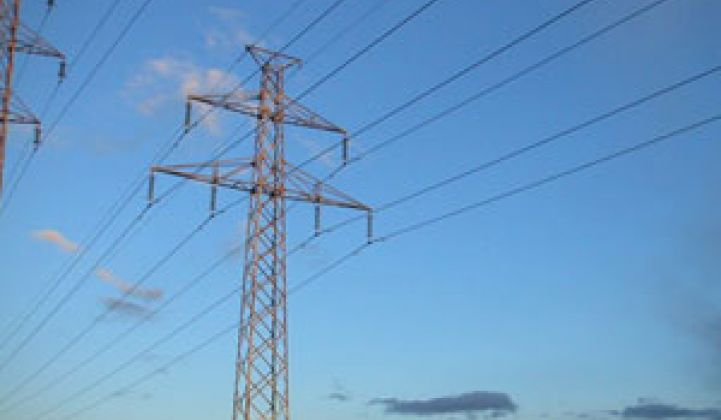A boost in wind energy generation in the eastern half of the United States will require roughly $80 billion in new transmission lines by 2024, said major electric grid operators Monday.
If the country wants 20 percent of its electricity from wind – or an additional 229 gigawatts of wind energy capacity – then it will need to build 15,000 miles of new transmission lines. That cost doesn't include the $1.1 trillion that will be needed to build wind power farms, said the grid operators in a report (see executive summary).
If the country gets only 5 percent of its electricity from wind by 2024 – or an additional 60 gigawatts of wind energy capacity – then the grid needs to add about 10,000 new transmission lines costing roughly $50 billion. The cost of building wind farms could reach $700 billion.
Wind energy accounted for less than 1 percent of the country's electricity supply in 2007, according to the federal Energy Information Administration. Overall, 7 percent of the country's electricity supply in 2007 came from renewable sources, with a bulk of it coming from biomass and hydroelectric generation.
The report was a preliminary assessment by grid operators to determine what the grid should look like to meet a growing national demand for renewable energy. President Obama has called for the country to double its renewable energy production in three years, a goal meant to create new jobs while moving the country away from building more coal-fired power plants.
The consortium is made up of Midwest ISO, Southwest Power Pool, PJM Interconnection, the Tennessee Valley Authority, Mid-Continental Area Power Pool and power companies within the SERC Reliability Corp. The study also looked at New York and New England.
The nation has seen an explosive growth in wind power, which is considered by some utilities to be cheaper than solar. The United States overtook Germany as the world's largest wind energy producer in 2008. Texas leads the nation in wind energy generation, and currently has about 7.1 gigawatts in capacity, according to the American Wind Energy Association.
The grid hasn't improved as quickly as the growth in renewable energy growth in some regions of the country, however. In Texas, grid congestion isn't uncommon, and state regulators recently approved $5 billion worth of transmission projects (see Texas Wind Farms Paying People to Take Power).
Several other power companies throughout the country also recently announced transmission projects. Ratepayers typically end up paying for this type of projects, and approval for rate increases often must come from states. With renewable energy generation receiving popular support from state and federal lawmakers, as well as the public, getting those rate increases approved could prove easier under the current political climate.
Of course, there is no assurance that building new transmission lines for ferrying wind or solar power would get strong public support. The California Public Utilities Commission approved a controversial, $2 billion project last December after three years worth of hearings and debates over where those transmission lines would be located and whether the utility in question would even use the lines for renewable energy (see California OKs Controversial Transmission Project).
ITC Holdings Corp. on Monday proposed a project to build 3,000 miles of extra-high voltage lines (765 kV) to ship wind energy from North and South Dakota, Minnesota and Iowa to other Midwestern states. ITC, based in Novi, Mich., said the project would cost an estimated $10 billion to $12 billion.
ITC said the project would be adequate to move 12 gigawatts worth of wind power.
The U.S. Department of Agriculture last week said he had aside $356 million for rural utilities and cooperatives to upgrade their transmission networks. Some of those new capacities would be used to support wind and other renewable energy developments (see Farmers Need a Better Grid, Too).



